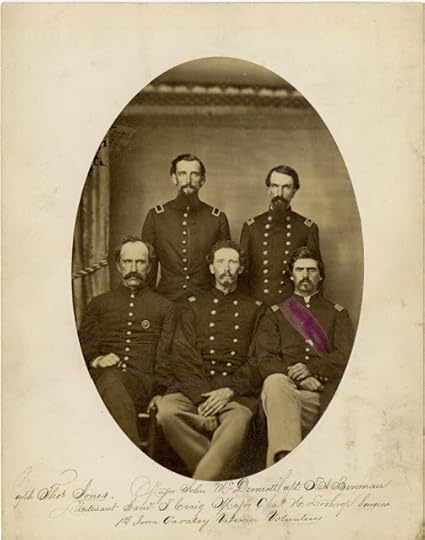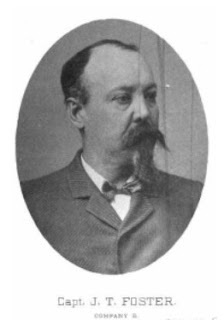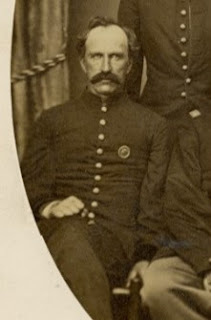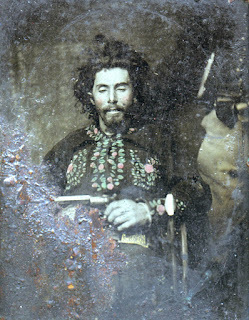A Blackened Page of History: The Aftermath of the Centralia Massacre
After gathering the bodies of his slain comrades,murdered at the hands of Bloody Bill Anderson and his band of guerillas outsidethe town of Centralia, Missouri in September 1864, one Iowa captain resolved toseek revenge for the deaths of his men.
“I arrived onthe ground the morning after the massacre and received a detailed account of itfrom an eyewitness,” he wrote to a friend in Illinois. “I had a small detail tolook after the murdered men of our own regiment, as it was known that seven ofthem had been on the train. I was not long in finding them, but in an awfullymangled condition. The butchers had thrown some of them across the track andcompelled the engineer to run a construction train over them. There were twomen from my own company among the slain and I found one of them with ninebullet holes in him and his throat cut. The other one had three bullets and histhroat cut. Now talk of peace with such a race, will you? I have made a vow tobe revenged for the murder of my two boys, and I will have it with a big premiumbefore I leave this state if the authorities don’t watch me too closely…”
The letter waspublished unsigned, but I strongly suspect was written by Captain Thomas Jonesof Co. C of the 1st Iowa Cavalry. It first saw publication in theOctober 19, 1864, edition of the Wilmington Independent published in Wilmington, Illinois.
 This photo of five officers of the 1st Iowa Volunteer Cavalry, depicts the soldier that I believe wrote this description of the Centralia Massacre, Captain Thomas Jones of Co. C who sits at bottom left. The officers, all identified, are as follows: Jones, bottom row left, Major John McDermott at center, Captain T.A. Bereman at right. Top row left is Lieutenant Samuel T. Craig and at right, Major Charles Lothrop. (Wilson's Creek National Battlefield)
This photo of five officers of the 1st Iowa Volunteer Cavalry, depicts the soldier that I believe wrote this description of the Centralia Massacre, Captain Thomas Jones of Co. C who sits at bottom left. The officers, all identified, are as follows: Jones, bottom row left, Major John McDermott at center, Captain T.A. Bereman at right. Top row left is Lieutenant Samuel T. Craig and at right, Major Charles Lothrop. (Wilson's Creek National Battlefield) Mexico, Missouri
October 2, 1864
On the 27thof September, as the train going west from St. Louis to Macon City was passing Centralia,13 miles west of this place, it was stopped by a band of men claiming to beConfederate soldiers, but dressed in Federal uniform, and robbed of all thevaluables and money upon the passengers and express. They compelled thepassengers to get off the train which they set fire to and started off withoutengineer or conductor.
There were alarge number of discharged soldiers on their way to see their loved ones athome after having served out their time, but alas, that home they were destinednever to see. After collecting all the booty they could find, they proceeded totheir more hellish and brutal acts. They marched out all who wore any portionof the Federal uniform and shot them down like dogs, mangling and mutilatingthem in the most horrible manner.
I arrived onthe ground the morning after the massacre and received a detailed account of itfrom an eyewitness. I had a small detail to look after the murdered men of ourown regiment, as it was known that seven of them had been on the train. I wasnot long in finding them, but in an awfully mangled condition. The butchers hadthrown some of them across the track and compelled the engineer to run aconstruction train over them. There were two men from my own company among theslain and I found one of them with nine bullet holes in him and his throat cut.The other one had three bullets and his throat cut. These were men who had gonethrough many dangers and always did their duty bravely.
We brought thepoor fellows to this place and gave them a decent burial. We picked up 27 othersand brought them here; this was all we could transport. There 155 others whomwe buried near where they fell. Two others had crawled away some distance anddied, making a total of 157 souls.
Now talk ofpeace with such a race, will you? I have made a vow to be revenged for themurder of my two boys, and I will have it with a big premium before I leavethis state if the authorities don’t watch me too closely as I am set for themand am not compelled to make report of all that transpires while out scouting.

The CentraliaMassacre was actually a two-part affair; the first event, described above, occurredon the morning of September 27, 1864, and resulted in a total of 22 soldiersand a single civilian being murdered. Later that afternoon, a detachment oftroops from the 39th Missouri Militia under Major Andrew V.E. Johnstonarrived and attacked Anderson’s camp. The militia were slaughtered nearly tothe man and their bodies left all about town- this became known as the Battle of Centralia.
General Clinton B. Fisk messagedhis commanding officer General William S. Rosecrans a few days later that Major Johnston's command was “completely overwhelmed and himself and command subjected to the mostinhuman butchery and barbarities that blacken the pages of history. MajorJohnston was murdered and scalped, 130 of his officers and men shared his fate.Most of them were shot through the head, then scalped, bayonets thrust throughthem, ears and noses cut off, and privates torn off and thrust into the mouthsof the dying. The heart sickens and the mind recoils at the recital andcontemplation of the barbarous atrocities.”
It took a fairamount of detective work to land on the probable author of this letter asCaptain Thomas Jones of Co. C of the 1st Iowa Cavalry. This letter,unsigned, was described as being from “a captain in an Iowa cavalry regimentwriting to his friend in this town,” that town being Wilmington, Illinois.
The first task became narrowingdown which Iowa cavalry regiment might have had troops either mustering out or activein Missouri in late September 1864. A quick search of the regimental servicesof Iowa’s cavalry regiments narrowed it down to the 1st and 3rdregiments. A deeper read of the History of Boone County’s account of theCentralia Massacre makes mention of a soldier of the 1st Iowa Cavalrycalling out the guerillas while still on board the train.
LurtonIngersoll’s compendium of histories of Iowa regiments during the Civil War sealedthe deal. In his account of the services of the 1st Iowa Cavalry, hestates that “on the 27th of September, the savage guerilla BillAnderson attacked and captured a train near Centralia and atrociously murderedall the soldiers aboard, numbering about 30, of whom seven were members of the1st Iowa Cavalry.” Seven men matched exactly what our correspondentstated was his regiment’s loss in that bloody affair. So, it is the 1stIowa Cavalry.
Ingersoll then gave the names ofthe seven men of the 1st Iowa Cavalry who were murdered, which are as follows:
Private Owen P. Gore, Co. A
Private Oscar G. Williams, Co. B
Private George W. Dilley, Co. B
Private John Russell, Co. C
Private Charles E. Madera, Co. C
Corporal Joseph H. Arnold, Co. E
Private Charles G. Carpenter, Co. K
You mightrecall that our correspondent specifically mentioned finding two members of hiscompany, which narrowed it down to the captain of either Co. B or Co. C of the1st Iowa Cavalry. A quick search of the rosters of both companiesyielded a pair of candidates:

Captain Joseph T. Foster, of Co. B. Fosterenlisted from Lyons, Iowa as the 21-year-old Fourth Sergeant of Co. B on May 1,1861, and progressively moved up the ranks, first to battalion sergeant majoron October 7, 1861, orderly sergeant of Co. B on September 1, 1862, first lieutenanton December 21, 1862, and captain of August 5, 1864. He was wounded July 11,1862, during the engagement at Big Creek Bluffs, Missouri. After being musteredout of service with the 1st Iowa on February 15, 1866, he accepted acommission as first lieutenant in the 8th U.S. Cavalry and servedwith the regulars until he was dismissed December 28, 1868.

Captain Thomas Jones of Co. C. Jonesenlisted from Towanda, Illinois as a 31-year-old private in Co. C on June 13,1861. Jones became orderly sergeant of the company on October 7, 1861, and wassuccessively promoted to second lieutenant on July 1, 1862, first lieutenant onDecember 12, 1862, and finally to captain on February 14, 1863. Jones wasdischarged on December 16, 1864, at St. Louis, Missouri.
The fact thatJones was a resident of Towanda, Illinois, a town along the railroad betweenChicago and Wilmington, leads me to believe that the most probable author ofthe letter was Jones and not Foster, but I can’t say that with absolute certainty.What I can say with certainty is that the letter, a grisly account of theaftermath of the Centralia Massacre, was written by one of these two officersof the 1st Iowa Cavalry.
 Bill Anderson photographed a month after the Centralia Massacre, killed in a skirmish with Federal troops.
Bill Anderson photographed a month after the Centralia Massacre, killed in a skirmish with Federal troops. It is worthnoting that Bloody Bill Anderson’s days of terror were numbered, and his endreflects the epitome of savagery that gripped the Missouri frontier in the waningdays of the Civil War. Scarcely a month at the events at Centralia, Andersonwas shot behind the ear and instantly killed while charging against a Federaldetachment near Albany, Missouri. His body was taken to nearby Richmond,Missouri, photographed, and paraded around town; one soldier cut off his fingerto steal a ring. A pair of brothers, Frank and Jesse James, who rode with Anderson, went on to notorious careers as desperadoes in the Wild West of the post-CivilWar era.
Source:
Letter from Captain Thomas Jones, Co. C, 1st IowaVolunteer Cavalry, Wilmington Independent (Illinois), October 19, 1864,pg. 2
Daniel A. Masters's Blog
- Daniel A. Masters's profile
- 1 follower



